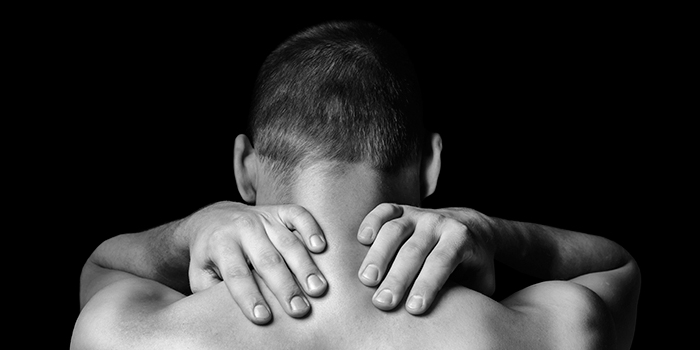
Have you ever caught yourself saying, “I thought exercise was going to make me feel good, but now I feel worse than ever?” This is somewhat common with people who are new to exercising. The fact is that if you have any designs on changing your body for the better, you are going to spend some time being sore. It’s inevitable. Fact of life: there is some pain associated with the ultimate pleasure of being fit.
Also, if you anticipate, plan, and take the proper steps, you can minimize your soreness.
Learn good pain from bad.
There are generally two types of pain associated with working out: pain from muscle soreness (microtrauma) and pain from injury (trauma as you know it). It’s not always clear which is which, so tread lightly until you know the difference. There is no absolute way to tell, but if your soreness lessens as you warm-up, there’s a very good chance you’re dealing with microtrauma. Increasing pain doesn’t necessarily mean you’re injured, but it means you shouldn’t exercise that day. If this doesn’t change in a day or two, injury is likely and you should see a professional. Microtrauma always improves over time.
Embrace the pain.
This idea is going to be foreign to many of you but eventually you’ll learn that a little soreness means you’ve embarked on something that is good for you. The first time, however, you’re going to have to show a little faith. Whenever I switch up my training, I go through an initial period of soreness. While it’s always bothersome, especially say, when it hurts to take off my shoes or wash my hair, I know that it’s only temporary and that it’s an important step along the road to my goal. So I embrace it. Sure, it hurts. But it hurts in a good way. A great way even. I love the beginning of a new training cycle because I know that once I work through the pain, I’m going to be fitter than before. In fact, when I haven’t had a period of soreness in a while, I start to feel like a slacker.
Anticipate.
Remember to go easy on your first day. And I mean E-A-S-Y! It’s normal to get excited on day one. You’ve got a new package in the mail and visions of you walking down the beach turning heads are probably dancing in your head. This is great, but keep your wits about you. You’re not going to get that way tomorrow or the next day. Hammering through your first workout could end up delaying your program two weeks while you recover from your exuberance. Instead, start slow. Do much less than you feel like you could. You’ll get sore anyway. Next day, push a bit harder. Next day, a bit harder still. Easing into a program is the best way to make steady progress.
Eat well.
The more you exercise, the better you need to eat. Junk won’t fuel your muscles properly. This is especially true if you are trying to lose weight because you are eating less than you need to sustain your body. So what you eat becomes vital. The better you eat, the less sore you’ll be. Try to exercise on an empty stomach and then eat a small snack that is approximately 4 parts carbs to 1 part protein within an hour of finishing your workout. This will greatly help the recovery process and reduce soreness.
Stretch after you work out.
The more time you can spend doing extra stretching at the end of your workout, the better you’ll recover. Don’t stretch your muscles when cold, as you’ll risk injuring them further. An extra 10 minutes after you work out, however, can do wonders. Also, easy movements and stretches at night before bed and again first thing in the morning helps your blood circulate better and will also improve your recovery time.
Massage.
You don’t have to go to a masseuse; self-massage is a great tool to aid recovery. The only time you don’t want to massage your muscles is right after you work out because you will interfere with the natural recovery process. But at any other time, just five minutes of self-massage can do wonders.
Ice.
More on the circulation theme—nothing moves blood around like ice. It causes blood vessels to contract at first, and then open as you get used to it. If you’ve ever watched a locker room interview after a sporting event, you probably noticed that a lot of the athletes were icing parts of their body. That’s because it’s one of the greatest recovery aids we have available. Almost all injuries heal quicker if you apply ice. And soreness is “microtrauma,” or slight tears in your muscle tissue. These are necessary in order to get stronger, and they will heal faster if you ice them. You can ice any sore body part up to 20 minutes at a time, a few times throughout the day—if you can stand it, though you get used to it the more you do it.
Work out.
Often the last thing you feel like doing when you’re sore but it gets back to the circulation thing. Working out promotes circulation. Sitting around while you’re sore is worse than working out, even though you probably feel like exercise is the last thing you should do. What you should do is not work out too hard. Warm up and then do part of your scheduled workout. Maybe half, maybe just a quarter. Use the extra time after the cool-down to stretch and/or ice. It’s a good excuse to be slightly lazy, since you are doing what’s often called a “recovery workout,” which is aimed at not breaking down too much muscle tissue. However, if your legs are sore, you don’t have to go easy on your upper body, and vice versa.





No comments:
Post a Comment